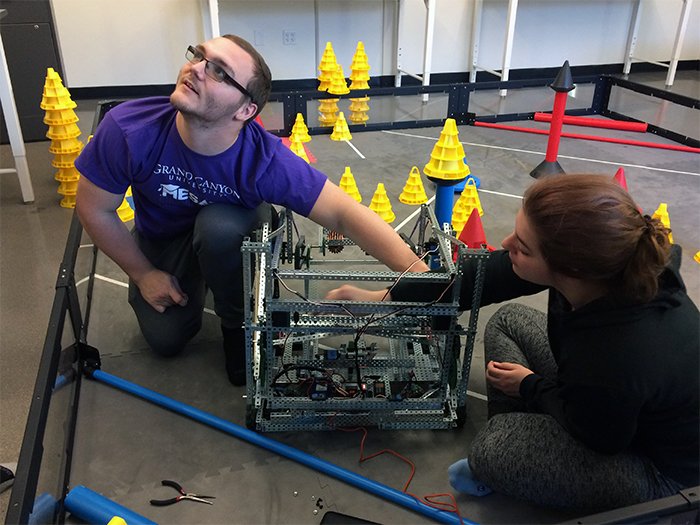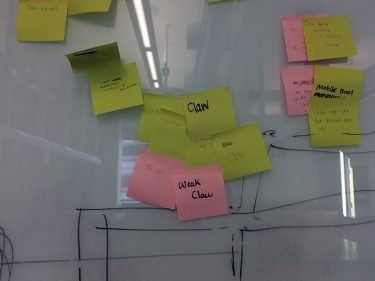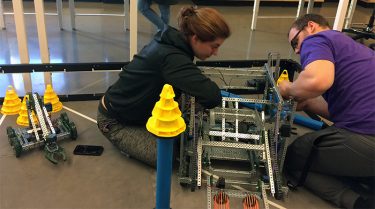
By Lana Sweeten-Shults
GCU News Bureau
Thunderbot, Grand Canyon University’s friendly neighborhood competition robot, looks as if it survived a horrible lab accident – gasp! -- where it was exposed to dangerous levels of gamma radiation.
Left in the wake: a gingerly engineered robot Hulk -- Thunderbot 2.0, if you will -- that the GCU Robotics Club has lovingly dubbed Tim, for “Team in Motion” (though if you ask some of the students, they'll say it’s a nod to GCU Colangelo College of Business assistant professor Tim Kelley).
Tim the Thunderbot is a huge 23x23x23.5-inch monster of a 'bot that’s double the size of the club’s first competition robot (the ’bot must fit into a 24-inch cube); when prompted, it can "grow" to up to 3 feet tall.
The club went into high gear with this build after its debut competition in November at a regional VEX In the Zone robotics event. Not knowing what to expect, the club decided not to design anything too elaborate.
This time around, as the GCU team prepares for the Southwest Vex U Regional Qualifier Tournament on Saturday at Embry-Riddle Aeronautical University in Prescott, Ariz., the club is going for it.
Bring on the elaborate.
Inspired by engineering concepts used by other teams at that first competition, the team went back to the drawing board, covering a whiteboard in Building 1's second-floor Robotics Lab with yellow and pink sticky notes during a brainstorming session.
“Weak Claw.” “Can only stack three cones max.” “Cannot lift one mobile goal up.”
Then the team zipped along, like snaggle-toothed engineering madmen, to overcome those weaknesses in the Thunderbot 2.0 build.
The new robot touts a lifting arm that extends far above the stationary goals on the competition field. Per sticky-note observation, the previous robot arm wasn’t long enough to stack more than three cones on those goals (cone-stacking is a prime point-garnering activity).

Also, “We have a vacuum-type claw instead of an open-close claw, so it sucks the cones up with rubber-banded gears. We still have omnidirectional wheels, so that hasn’t changed. And we are now using 10 motors on the ’bot instead of just three,” said Makayla Jewell, a sophomore engineering major who, when she’s not helming the Robotics Club as its president, dreams of one day engineering prosthetic hearts.
Mechanical engineering major and competition robot driver Talon Birdsong said, “We went in with more of a plan of what we wanted to do and what we needed for the competition, making the ’bot reach higher and actually lifting the mobile goal into the ’bot instead of pushing it around.”
Thunderbot 2.0 doesn’t just tout rubber bands on its vacuum-type claw (the bands help suck in the cones) but rubber bands in other areas, Birdsong said, to help counter the force of the weight of those cones “without the force of gravity being too much for the motor.”
Collegiate-level teams have 45 seconds to score points during an autonomous period, meaning the robot controls itself, followed by 1 minute and 15 seconds to pile on more points during a driver-controlled period.
VEX calls it "the world's greatest two minutes in robotics."
Unlike TV’s “Robot Wars” or “BattleBots,” robots don’t go onto the field of play, hair all ablaze, so to speak, and ready to battle one another to the robot death in gladiator fashion. Instead, the VEX competition is task-oriented.
Collegiate teams earn points by stacking yellow cones on stationary goals (a possible 80 cones may be stacked on 10 goals), placing mobile goals in goal zones, having the highest stack and for parking the robot. A bonus is awarded to the team with the most points at the end of the autonomous period.
At the first competition, the team couldn't make its autonomous mode work until two days before the competition. This time around, “the autonomous (mode) will be properly programmed,” Jewell said.
Jacqueline Jacobson, a freshman robotics engineering major and one of the GCU Robotics Club’s programmers, was sitting crisscross on Wednesday in the middle of a VEX competition practice game field purchased recently through appropriations from the Associated Students of GCU. The practice field, a 12x12-foot foam mat surrounded by a perimeter and dappled with yellow, red and blue cones, stationary goals and colored scoring zones, is identical to the real field of play the team will compete in on Saturday.
With her shoes off (no shoes are allowed in the arena) and a laptop in hand, she was busy perfecting the programming for Tim the Thunderbot using a computer language called Robot-C.
“It’s like the programming language C, but the VEX Corp. has their own programming language. It’s already calibrated for their motors, their batteries,” said Jacobson, who competed in robotics events in high school.
At a lab table next to her, right outside of the practice field, sophomore health care administration major Hannah Baptista worked on a Google Docs file that documents everything the team has done to program, engineer and build the robot.

Baptista got into robotics thanks to Jewell: “I enjoy learning new things,” she said, and although it might seem like robotics has nothing to do with health care administration, she said technology is incorporated into everything these days, including health care.
Other club members will place that documentation in a notebook that the judges will review -- a robotics log of sorts.
The documentation is included in the judges’ assessment of the robotics teams. As Robotics Club faculty advisor and electrical engineering technology instructor Ed Koeneman said, these robotics events are designed to teach competitors good engineering skills, and a big part of engineering is documentation and communication.
The Robotics Club has been building this latest competition robot for the past three weeks, though they started brainstorming ideas in December, after that first competition. Since the second week of January, the club has been meeting for two hours a night three days a week to get ready for the Southwest VEX U Regional Qualifier this weekend.
About 20 of the GCU club’s 30 members will be at the competition. They want to make it to the top three, which would qualify the team for the VEX U World Championship.
“They’re very dedicated,” Koeneman said of the team, and they’re excited to see what their hulking Thunderbot 2.0 is able to do.
As Jacobson said, “I’m really just proud that it works. I never had a ’bot that works this well and this consistently. … Dang, I want to show this robot off!”
You can reach GCU senior writer Lana Sweeten-Shults at 602-639-7901 or by email at [email protected]. Follow her on Twitter @LanaSweetenShul.















